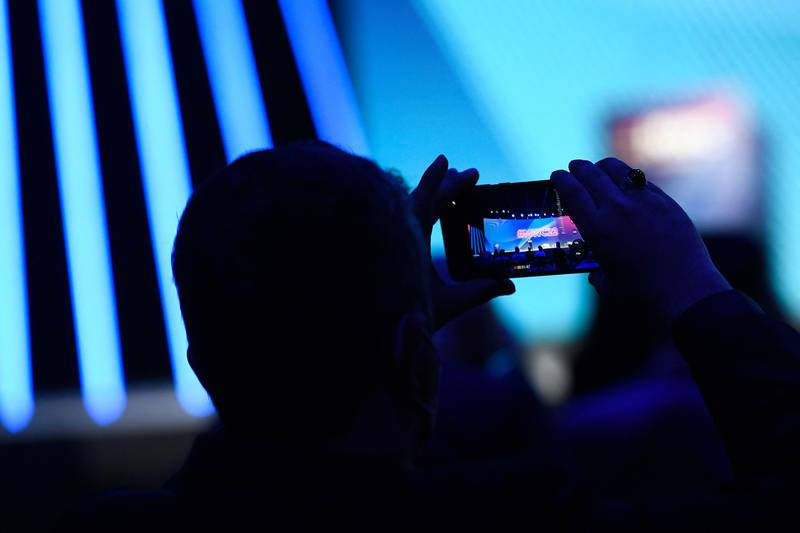Why 2023 is expected to be another big year for smartphone cameras
31 December, 2022

Smartphone cameras have not only played a large role in defining the legacy of one of the most important consumer products available today, but have also served as a microcosm of what is possible, cramming as much technology as possible into a confined space.
It is not surprising, therefore, that cameras are among the top features users continue to watch out for before purchasing a smartphone.
“The camera comes within the top three features of smartphones … it is very important to establish that a phone has a fantastic camera,” Ahmad Boarki, a UAE-based reviewer of consumer technology, told The National.
“There are times that I hold on to a phone longer and there are times when I can't wait to remove my SIM card out of the phone because it takes terrible pictures.”
Judging smartphone cameras can prove to be tough, especially with the innovation lines continuing to be blurred by a similar set of features across all devices. In The National's reviews of the Apple iPhone 14 line-up, Samsung's Galaxy S22 and foldables, we took into consideration camera functionality, image quality, ease of user experience and how much of an improvement they are from their predecessors.
Pricing is relative, since this takes into consideration what additional features a smartphone has or lacks.
DxOMark, one of the top smartphone aggregators globally, combines smartphone performance and the quality of the user experience. Their scores are backed up by “exhaustive protocols”.
The good number of ties in the top 10 — and throughout its list of more than 100 devices — are an indicator that smartphones apparently share similar features, albeit delivered differently.
“Smartphone cameras have turned everyone into a photographer … reliance on a smartphone camera means that image quality must be good in various usage conditions, from the easiest to the most challenging one, helping to capture the moment without any difficulty,” researchers at DxOMark said.
The number of photographs taken worldwide is expected to hit about 1.72 trillion in 2022 — up more than 43 per cent from last year's 1.2 trillion. And of this, about 1.6 trillion, or 92.5 per cent, will be taken on smartphones, according to data provider Photutorial.
Smartphone camera capabilities have equal importance to businesses, helping teams to co-ordinate complex tasks to keep operations running smoothly, said Abhay Ganesh, B2B category management lead at Samsung Electronics, the world's largest mobile phone manufacturer.
“Many enterprise teams rely on smartphones to quickly capture and share images and video … remote colleagues can see a more detailed view of everything they are collaborating on, whether it is a project site or an event space,” Mr Ganesh said.
Mr Boarki said smartphone manufacturers were expected to use more cameras that have triple-digit sensor counts — 100 megapixels and above — and combine them with even more advanced artificial intelligence and machine learning.
“I do not believe that smartphone cameras have peaked … we are going to see the best of [both] worlds in 2023,” he said
Samsung Galaxy S22 Ultra 5G: The details on lights are good and the overall results aren't overexposed. If you look closely, however, there is some blur with moving subjects or objects. A sample video also shows that it can hold up pretty well at night, although there is some grain in some of the darker areas.
Samsung Galaxy Flip 4: There are no veritable upgrades on this front but the Flip 4's cameras are up to the task, with clean, crisp shots. However, night or low-light shots tend to be grainy.
Samsung Galaxy Z Fold 4: In well-lit situations, colours are bright and rich, with clear details. At night, it also retains clarity — albeit with smudges — and one particular thing we like about it is how it processes lights, preventing scattered results and reflection. In either situation, there tends to be a little overexposure.
Apple iPhone 14: The device's Photonic Engine technology results in outstanding images. You will be able to control your focus with a few taps on the screen but, overall, the brightness, white balance and exposure blend in well with each other. Exposure is equal to the actual environment. The same goes for night shots, which are true to form.
Apple iPhone 14 Pro Max: The camera really stands out during night time. Video is also unquestionably good. A major reason for the iPhone's success in the past couple of years has been its cinematic mode, which Apple touts as being Hollywood-grade. The improved stabilisation offered by the device is also a big plus.
Apple iPhone 14 Plus: The results are at par with the 14, with images looking natural and not overexposed.
Source: www.thenationalnews.com
TAG(s):
